Mike Jastrzebski's Blog, page 34
October 9, 2013
Completing the “milk run”

Our boat tied to the dock inside the lagoon of the atoll Ahe in the Tuamotus, French Polynesia
by Christine Kling
Today it’s difficult to remember what life was like without GPS. Nothing has changed the life of the cruising sailor as much. Having to find one’s location with a sextant and celestial navigation was so dependent on weather and the navigator’s ability. If the seas were extremely rough, it became much more difficult to get a fix and made star fixes on a small boat almost impossible. When it was overcast, you could only continue your dead reckoning from your last fix. When we sailed from Hawaii to California, our passage took 23 days and we had solid overcast for the last 9 days of the trip – meaning no fix was possible. And night time entrances to a strange port were never even considered as they are today with our glow-in-the-dark chart plotters.
The other thing that celestial navigation impacted was cruisers’ decisions of where to go. There was a route across the South Pacific that was considered the “Milk Run” and only the most courageous sailors veered off that route. For example, the Tuamotu Archipelago covers a huge area between the Marquesas and the Society Islands. There are over 70 islands in the Tuamotus but most cruising sailors in the 1970′s only visited the islands around the edges as they are atolls that are only visible from about 5 miles off. We stopped at Ahe and at Rangiroa, and I’ll never forget sailing along the coast of Ahe and counting the number of sailboat wrecks visible high up on the island’s beaches. It was a frightening reminder of how dangerous it could be to get off course and arrive at the island in the dark.
Today, I’m sure cruisers visit many other islands in the Tuamotus and throughout the South Pacific because GPS has made it possible. It has opened up vast new areas for the cautious cruising sailor.
The end of the “Milk Run” across the islands of the South Pacific ended for us with a 10-day passage down to the Bay of Islands in New Zealand. On our low tech cruising boat we only had an all-band receiver for a radio and our entertainment in the evenings on that passage was to tune in to the cruiser’s net on the ham radio bands and listen to them discussing how to figure out where they were. On that trip from Tonga to New Zealand, you see, we crossed the International Dateline or 180 degrees of longitude. For the folks who had learned a certain rote formula for celestial navigation and didn’t understand the theory, they were suddenly faced with a mathematical dilemma. How did they differentiate the numbers when they changed from west longitude to east longitude and their numbers that had been increasing started to decrease? It made for several evenings of amusing radio chatter.
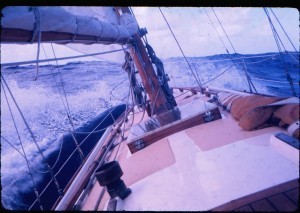 On that ten day passage as we sailed farther and farther south, we encountered a couple of nasty gales that let us know we were approaching the Southern Ocean. Long pants and sweaters got pulled out of lockers and night watches seemed to grow frigid. Finally, we sailed into the protected waters of the Bay of Islands with barely enough daylight left to make our intended anchorage off the town of Russell.
On that ten day passage as we sailed farther and farther south, we encountered a couple of nasty gales that let us know we were approaching the Southern Ocean. Long pants and sweaters got pulled out of lockers and night watches seemed to grow frigid. Finally, we sailed into the protected waters of the Bay of Islands with barely enough daylight left to make our intended anchorage off the town of Russell.
Several years previously when Jim had lived in California he had been best friends with another boat builder – a Brit by the name of Denis Brown. Denis had designed and built his boat Ravensong and left for the South Pacific a few years before Jim. Somewhere along our route in the months we passed through those islands, Jim had written Denis and his wife Eva telling them that we were planning to spend the southern summer’s hurricane season in New Zealand. Denis had told his friends with hilltop houses to keep a look-out for our Islander 44 with a varnished spruce mast to come sailing into the bay. We, of course, had no radio to call ahead and tell Denis of our arrival.
So, imagine our surprise when after ten days of fighting a cold rough sea, we barely got our yellow Q flag up and our anchor into the water when a lovely lapstrake skiff pulled alongside and there was Denis at the oars welcoming us to New Zealand with a loaf of fresh bread and a glass bottle of non-homogenized milk with two inches of cream on top.
At the end of our milk run, we’d found our home for the next six months.
Fair winds!
Christine
Share on Facebook
October 7, 2013
Research – even when it hurts!
Michael Haskins/ www.michaelhaskins.net
Writing requires more than sitting in front a blank page and finding that elusive first sentence. An idea has to be planted in the writers head, and God only knows how many ways there is for that to happen. Once the idea has fermented, most of us have to do research. Surprisingly, most writers don’t know it all, especially in the field of crime. If we aren’t ex-cops or military or special ops, there’s research; and there’s searching out people in the fields we need to know about.
But it can be simpler than that. Just because something was, doesn’t mean it is.
In point, I am writing a yet to be named, new Mick Murphy Key West Mystery. In the first 100 pages, I have Murphy going to Los Angeles in search of his cousin Cecil, an ex-IRA man. Murphy last saw Cecil, almost 20 years ago, when he bartended at an IRA pub in LA, Molly Malone’s. It’s fiction, of course, but I spent almost 20 years sitting in the real Molly Malone’s, singing rebel songs, picketing the British Consul a few block away, learning to do the Irish jig from the Sweeny sisters. There really was a bartender named Cecil. An ex-Catholic priest and a damn good goldsmith.
I wrote Molly’s as I remembered it. I searched the web and found out the same family owned it. I was excited. I knew Angela, part of the family that owned the pub, I knew many of the bartenders and could find my way to the men’s room with my eyes closed. The singer, Colm Gallagher played at my twin daughters’ christening. Backyard, Irish music, front yard the Mariachis tuning up, waiting for their turn to entertain. Irish-Latin, the most dangerous mixture of races there is. Think Che Guevara.
Yup, I was going back to make sure I got the ‘feel’ of Molly’s in the story. I wanted to smell the dark walls, the oil paint of the hundreds of paintings on the walls. Can’t remember his name, but a popular local artist did portraits of the staff and Irish figures in history and I think that’s how he paid his bar tab. Angela hung them all on the walls of the small bar.
My sister Patty and her friend Nat drove with me to the Fairfax district. There it was, the tri-color, flying proudly over the entrance. Nothing outside had changed. I would have cried with joy, but I knew the women wouldn’t understand. My misspent youth stared at me.
I opened the door like a lover caressing his woman after being away on a long trip. The brightness of the lighted inside blinded me! Patty and Nat walked in, I followed. I found out while I was away my lover had cheated . . . a lot it seemed.
The low ceiling had moved about 20-feet up and track lighting lit the walls and bar. And the bar! God how’d you allow such a thing. Someone had sandblasted it to show the brink, removed the mirror and old shelves and put up glass shelves. The stage was gone and no rebel music hummed through the hidden speakers – which weren’t there anyway.
Colm’s small one-man stage was gone and a dark board replaced it. The room was so bright I could see the floor and into the kitchen. I sulked off to the men’s room, smiled because it remained small and old. I came back out and had a Guinness. Patty and Nat had whatever.
Back when, the bartenders had brogues, this bartender spoke with a Spanish accent. We had come to have lunch, but the women never mentioned it. The paintings were still on the walls and I almost smiled when I walked by each one. My favorite had always been the portrait of the local actor portraying Brendan Behan.
We ate lunch at the Farmer’s Market, a few blocks up Fairfax.
Nat took photos of me on her cell and posted them on her FaceBook page. When I got back to my sister’s I saw the post and wondered if I really looked that miserable. Inside I did, but didn’t realized it showed.
I got on my laptop and wondered how to rewrite the chapters that had Molly’s in it. I thought about showing Mick Murphy’s disappointment, but finally chose ‘change’ on Word and made Molly Malone’s to another Irish pub and left it at that. I guess you really can’t go home again.
If I hadn’t done my research, I would have looked foolish to readers that were familiar with today’s Molly Malone’s and would have turned those readers off. Those that remember the pub for the 70s,80s and 90s, will know what I am writing about. I changed the name, but not the location.
So, research of things you take for granted is also necessary. Even when it hurts.
Share on Facebook
October 6, 2013
Living with Wes Darling
By Mike Jastrzebski
As a writer I’m often asked where do my story ideas come from, followed by, are any of your characters real people. The answer to the first question is that they just appear in my head. The truth of the matter is that I have more story ideas than I’ll ever write. The answer to the second question is a little more complex.
You see, I first met Wes Darling while I was living on a mooring ball in the Garrison Bight mooring field in Key West. It’s no coincidence that Wes lives on an Islander 36 sailboat. It’s the same boat I’ve lived on for ten years now. I know the boat, but Wes is probably a better mechanic and a better sailor. In fact, Wes is younger than I am, smarter, stronger, and better looking. He’s also way cooler than I am. In fact, Wes is everything I wish I could have been thirty years ago, and that’s a hell of a lot for an old sailor like me to live with.
Of course, he wasn’t always Wes Darling either. When Wes first came into my life his name was Jason Wolfe and I was living at the Grand Mariner Marina on Dog River in Mobile, AL. Jason had a different family than Wes, a different back story, and a different personality than the Wes Darling I got to know in Key West.
And it was only after I wrote Key Lime Blues (Wes Darling Book 1) that Wes fully came to life for me. Then it was nothing to send him back to Mobile and write about his adventures on and around Dog River in Dog River Blues (Wes Darling Book 2)
that Wes fully came to life for me. Then it was nothing to send him back to Mobile and write about his adventures on and around Dog River in Dog River Blues (Wes Darling Book 2) .
.
Along the way I realized that I live with Wes Darling pretty much 24/7. As I work on the third book in the series, Stranded Naked Blues, and I think about ideas for a fourth or fifth book in the series, I wonder if living with Wes Darling makes me a little crazy? Of course, I’ve often wondered if a person doesn’t have to be a little crazy to be a writer, especially a fiction writer. After all, we spend months and years living with characters that don’t exist and writing about things that never happened. Sounds like a good definition of crazy to me.
Share on Facebook
October 5, 2013
Family

by Christine Kling
Those of you who read this blog regularly will have noticed that we detoured from our routine here at Write on the Water over the last few days. We decided it was important that John Urban’s eloquent eulogy for his nephew Mark stay at the top of the blog until Mark’s service on Friday. There is no doubt it was the right decision as the post has had over 2000 hits and many people who had known Mark over the course of his too short life were able to find John’s words.
Mike J. started this blog three and a half years ago and while some writers have come on board and guested in the intervening years, others have left but remained with us as readers. We have some readers who have been with us almost from the beginning, too. Who knew back then that this blog thing would last so long or that it would change our lives? But a funny thing has happened over the years — we’ve become like family — the WOW family.
When C.E.’s home was struck by Hurricane Sandy, we all worried about her, and we’ve been cheering her on as she and her family have endured the long recovery from that terrible storm’s damage. When Mike and Mary got fed up with their cranky engine and declared they were done with cruising, we all felt the desire to buy them a drink and convince them that this problem was surmountable — not worth giving up the dream. When Michael Haskins wrote about the death of a Key West newspaper, we all wished we could buy him a cigar at the Smokin’ Tuna Saloon and commiserate about all the unhappy changes we see in paradise. And as for me, I am the one in this crowd who lives a truly solitary life. There are many days that go by when I don’t talk to another human being (no wonder the Yorkshire Terror is so crazy, right?), so this blog has been a shoulder I could lean on — and often cry on — for more than three years.
So when John, our resident humorist and April Fools master prankster lost a member of his family, it was like Mark Urban was extended family, and we decided it could not be business as usual here. That’s what family does.
Fair winds!
Christine
Share on Facebook
September 30, 2013
In Memory of Mark
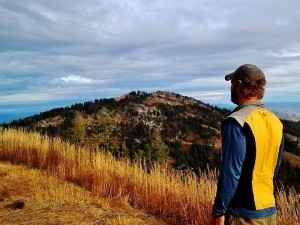
Frequent readers of my bi-weekly blog postings visit for a few minutes of escapism, perhaps even humor. Today, though, I write with sorrow over the tragic loss of my nephew, Mark Urban. While today’s entry is made at a time of great sorrow, it’s my hope that I am able to combine an account of this news with a celebration of a life lived fully.
Mark, who was 40, lived and worked in Idaho where he was a smoke jumper with the federal Bureau of Land Management. He had made hundreds of jumps over his 11 years as a smoke jumper, and he was a leader in the program, also overseeing rookie training. Last Friday, he participated in a high-altitude 6K foot descent that involved the testing of a new piece of equipment. Tragically, Mark’s parachute did not deploy properly.
Few words can describe the loss felt by Mark’s family – especially his wife, Becca, his parents and his sister – and all of his friends, none more than the close-knit family of smoke jumpers. Words do, however, serve as a starting point in celebrating a life lived fully.
Mark grew up in Western Massachusetts. “A great kid from the day he was born,” someone said this weekend. He sure was. Bikes, Spiderman (Spidey as I recall), Dukes of Hazard, Go-carts.
Mark was a strong swimmer from a young age, but by the time he was a freshman at East Longmeadow High School he was also playing football. Some years later I told him that I had a memory of a Thanksgiving Day football game with Mark, a free-style swimmer, lined-up against an opponent who must have weighed 300 pounds. Mark laughed when I shared the memory, but he knew the opposing player’s name – his weight, too (all of 300) – because he had that assignment several times over four years of varsity football.
Later, Mark studied forestry at UMASS -Amherst, with a brief National Guard stint in Europe supporting the peace operation in Bosnia. Following graduation, Mark needed only a few months behind a desk to confirm that his career choices would be driven by a need to be outdoors and he headed west.

(Mark and Becca – East Longmeadow High School Prom)
In Kohler, Wisconsin he led a crew on the construction of the Blackwolf Run golf course. The course designer, Pete Dye, took an interest in Mark’s career, but Mark’s focus was further west. In Lake Tahoe, Mark taught snowboarding at Heavenly during the day and he parked cars at the casino in the evening where tips from big winners funded surfing trips to California and Mexico. In the offseason, Mark began firefighting as a member of the California Interagency Hotshots, leading to his interest in becoming a smoke jumper.
Mark visited us in Rhode Island the year he was in training to be a smoke jumper. I remember being astounded by his marathon-type training runs with a final portion along the beach – all while wearing work boots. The next year, Mark joined the ranks of the Bureau of Land Management’s Smoke Jumpers in Idaho. In Boise, Mark settled in with the girl he had taken to his high school prom, and five years ago, Mark and Rebecca Ohlin married. Together, they bought a house and lived a life defined by a love of the outdoors, shared with others.
In many ways it would appear that Mark gravitated toward risk. I think, though, that it was the pull of nature and wonderment that defined Mark. He hiked and snowboarded back-country mountains that were off the worn track and he surfed, fished, and hunted in faraway areas. As a smoke jumper, Mark parachuted into the very most remote locations in the country.
Mark’s life of exploration was especially remarkable to those of us who were at home, working behind desks. We all admired Mark greatly. In fact, on the day before his death I was telling a co-worker how Mark had once driven across the country in his Jeep, stopping at night to rig one end of his hammock to the roll bar and the other end to a tree. During that same conversation last week I also said that Mark was cautious and well prepared, and that family and friends back home couldn’t get over that this motorcylce driving smoke jumper drove the speed limit on the highway.
Today, the loss is enormous. Our hearts ache. Yet, this Friday, a celebration of life will take place in Boise. In more than one way we will embrace the fact that this wonderful young man died while living.

(Mark Thomas Urban)
Share on Facebook
September 29, 2013
Now on audio
By Mike Jastrzebski
As I mentioned a couple of weeks ago I decided to have Key Lime Blues (Wes Darling Book 1) recorded as an audio book through ACX, and I had just sent the narrator the payment for the job (well done by Kevin Pierce I might add) and was waiting for approval by ACX.
recorded as an audio book through ACX, and I had just sent the narrator the payment for the job (well done by Kevin Pierce I might add) and was waiting for approval by ACX.
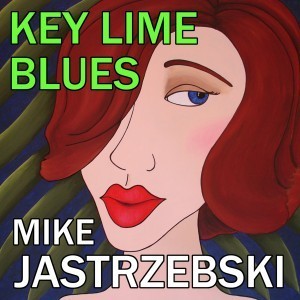
According to the information posted on the ACX website, I could expect the wait to be between 14 and 20 days. I received notification that the book was beginning the review process on 09/07/13. The audio book went live on Audible on the 26th. On the 28th the audio book went live on Amazon and in the Apple iTunes store.
If you’re interested in purchasing an audio copy of Key Lime Blues you can click on any of the links above, or you might want to consider signing up for a membership with Audible. They are currently offering a one month trial membership which would allow you to download Key Lime Blues for free.
Click here ( Key Lime Blues audio free with 1 month Audible trial membership )
September 27, 2013
Warming up to Twitter
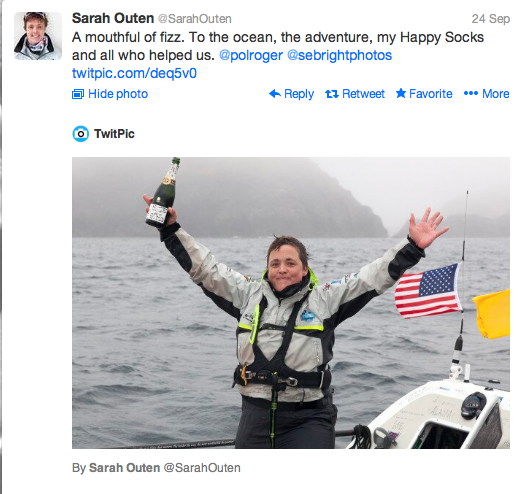 by Christine Kling
by Christine Kling
When I first heard about Twitter I thought it was ridiculous. “That will never work,” I said to myself. How can anyone say anything of note in only 140 characters? And when I first joined Twitter in March of 2008, it did seem like most of what was being written was garbage.
I’m never going to be someone who participates all the time on any social network, but I am beginning to really enjoy Twitter. I’m still mostly a lurker, but these days I’m finding this big open party line of text messages to be a fascinating place to hang out. Most people under the age of 50 probably don’t even know what a party line is, but I can remember being able to pick up the phone and listen to other people talking in our neighborhood. Twitter is like that on a global scale.

Perhaps one reason Twitter appeals to me is because I live alone and I have a very solitary profession. Talking to Twitter is usually better than talking to the dog. At least there is a better chance of getting an answer.
Sometimes it’s just fun to lurk and read the jokes and conversations of people I know, but rarely get to see. I can just picture Zoë at her writing desk working on her latest book and suddenly wanting to share a joke with someone. She types and a few minutes or a few hours later Sean responds. I know them both and there is something delightfully voyeuristic about getting to “overhear” their conversation.
 I’ve also created some lists for myself now that I’ve got too many followers to read in the main stream on my feed. I use TweetDeck and I can make columns there that only show the people on my list. I like lists because I want to filter out all the idiots who just post tweets that are shouting “Buy my book.” I have a list of authors, another list for sailing, and one that I just call “Interesting folk” where I see the most fascinating juxtapositions of ideas.
I’ve also created some lists for myself now that I’ve got too many followers to read in the main stream on my feed. I use TweetDeck and I can make columns there that only show the people on my list. I like lists because I want to filter out all the idiots who just post tweets that are shouting “Buy my book.” I have a list of authors, another list for sailing, and one that I just call “Interesting folk” where I see the most fascinating juxtapositions of ideas.
It’s very exciting to share in a conversation with a writer I really admire. Take Michael Gruber, for example. The Book of Air and Shadows is one of my all time favorite thrillers. I’m always waiting for his next book to come out. He has recently become quite active on Twitter, and I love his clever, cutting sense of humor. I can just go to his page and read back over several days of his tweets and be enthralled. Best of all is when he shows that he too finds writing a struggle.
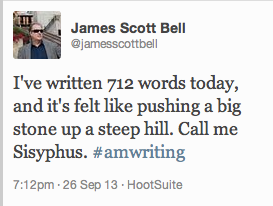 James Scott Bell is another author whose tweets make for fun and always interesting reading. He’s one of those guys who makes it look easy to be smart and funny in 140 characters. He’s also very fast and prolific with a record of over 18,000 tweets. I don’t know how people like him do it. I have to spend time to think before I publish a tweet. I don’t do “clever” well at all.
James Scott Bell is another author whose tweets make for fun and always interesting reading. He’s one of those guys who makes it look easy to be smart and funny in 140 characters. He’s also very fast and prolific with a record of over 18,000 tweets. I don’t know how people like him do it. I have to spend time to think before I publish a tweet. I don’t do “clever” well at all.
Who would have thought that these weird short writings would make me understand better just how many people there are in the world? It’s one thing to see a number like 3,000 people. It’s another thing entirely to see them all talking at once on the screen. 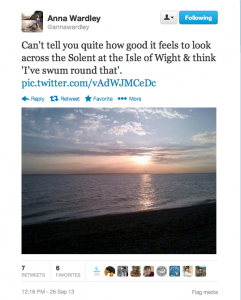 There are so many people out there doing interesting and wonderful things. Just today I discover the British woman whose tweet is at the top of this page — Sarah Outen who rowed from Japan to Alaska and spent 150 days alone in the North Pacific! She had already crossed Europe by bike and kayak, and I gather from her over 5,000 tweets, she has been tweeting every mile of the way. I imagine being able to send words out into the ether kept her sane during those 150 days alone at sea.
There are so many people out there doing interesting and wonderful things. Just today I discover the British woman whose tweet is at the top of this page — Sarah Outen who rowed from Japan to Alaska and spent 150 days alone in the North Pacific! She had already crossed Europe by bike and kayak, and I gather from her over 5,000 tweets, she has been tweeting every mile of the way. I imagine being able to send words out into the ether kept her sane during those 150 days alone at sea.
While reading posts about Sarah, I discovered Anna Wardley a Brit endurance swimmer who just swam around the Isle of Wight. The people who are doing extraordinary things tend to be connected to others like them. Without Twitter, though, most of us would only know about the TV celebrities or the Facebook feel good poster of the week.
In addition to people, I follow sailing magazines, non-profit organizations, the US Coast Guard, NOAA, publishers, etc. When there is breaking news like the Navy Yard shootings or the US winning the America’s Cup, it’s out there on Twitter long before it’s on CNN.
I’ve only just passed 500 tweets, so I’m still mostly a lurker. I don’t want to write garbage even though I recognize that often no one reads what I write. Writing something worth reading in only 140 characters is also a good exercise in conciseness. Occasionally I type out a bit of description of my own struggles and fire it out there. I’m always surprised when someone answers.

Fair winds!
Christine
Share on Facebook
September 26, 2013
You can’t make this stuff up…
C.E. Grundler
As twisted as my imagination might be, I’m forever discovering that it can’t hold a candle to the depravity found in the hearts of some humans. It’s been said that the truth is often stranger than fiction, which is why when I’m on the lookout for some writing inspiration, I’ll often take a peak at those shocking realities. I’m not a fan of mass media news – I don’t have the time or interest to filter past Miley Cyrus’s antics or what the Kardashians (weren’t they a race in the Star Trek universe?) are up to. No. I want my news filtered down to just the news I want, which is why I simply pull up a few pages I’ve bookmarked, and then brace myself for an onslaught of disturbing tales that leave even my muses shaking their heads.
Here – see for yourself…
http://www.newser.com/tag/2048/1/murder.html
http://www.topix.com/forum/news/violent-crime
http://www.huffingtonpost.com/news/murder/
And a little more eclectic, yet loaded with usefully unusual plots and schemes…
http://www.thefraudreport.com/
http://www.actionfraud.police.uk/news
http://abclocal.go.com/kgo/explore?tag=scam
But beware. Set a timer, lest you fall down the rabbit hole, only to discover half your day has slipped away, and after jumping from link to link, (and just when you thought it was safe to go back in the water,) you’ve somehow surfed your way to news like this…
Then again, who knows? Maybe a testicle-chomping fish in Passaic, New Jersey is just the twist I’ve been looking for. Like I said, you can’t make this stuff up!
Share on Facebook
September 24, 2013
A whale of a time in Tonga

by Christine Kling
What I remember most about the kingdom of Tonga is churches, fruit bats and whales.
When we visited Neiafu in the Vava’u group it looked like there were almost more churches than houses in the village. 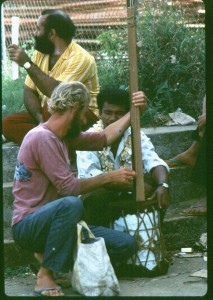 And on Sunday morning, the church bells were ringing non-stop and you could hear the music and the singing in stereo out in the anchorage. They loved their music and they crafted instruments out of whatever they had at hand. In the photo at left, Jim is admiring a Tongan version of the washtub fiddle. But what we found most remarkable was that the constitution in Tonga stated that Sunday was their Sabbath and it was required by law that no business of any sort could transpire on that day. In addition, it was illegal to engage in any game, sport, dancing or fishing. After having narrowly escaped jail for gun running in French Polynesia, we weren’t about to risk jail by snorkeling on Sunday.
And on Sunday morning, the church bells were ringing non-stop and you could hear the music and the singing in stereo out in the anchorage. They loved their music and they crafted instruments out of whatever they had at hand. In the photo at left, Jim is admiring a Tongan version of the washtub fiddle. But what we found most remarkable was that the constitution in Tonga stated that Sunday was their Sabbath and it was required by law that no business of any sort could transpire on that day. In addition, it was illegal to engage in any game, sport, dancing or fishing. After having narrowly escaped jail for gun running in French Polynesia, we weren’t about to risk jail by snorkeling on Sunday.
Another thing Tonga was known for was the fruit bats. We putt-putted in our dinghy out to one of the uninhabited little islands around Neiafu and found a whole colony hanging in the trees. They were creepy-looking, but fascinating creatures. Jim stood up in the dinghy and hollered and waved trying to get them to take flight. The ones we spotted weren’t nearly as lively as the ones in this video. Ours looked more like they were sound asleep.
It was our encounter with the whale — or I guess I should say the whalers — that made the strongest impression on me. When we visited Tonga in 1975, whaling was still legal and a fairly common practice. The original Polynesian people did not include whaling in their culture, but the practice was brought to the islands by Captain Cook and the New England whalers who followed.
So it was that when we were in Vava’u, an open wooden boat about 25 feet long took off one day with 6-8 men aboard. We heard in the village that they were going whaling. People said they often went out whaling, but they rarely caught a whale. Later that afternoon, however, we looked out from the anchorage, and we noticed the boat traveling quite fast between the little islands that you can see in the photo at the top of this page. The outboard wasn’t running and they weren’t rowing. They had harpooned a whale and the boat was being towed around as the whale swam and slowly tired itself out. This took several hours.
Close to dusk, the boat came motoring slowly into the anchorage. Lashed beneath the 25-foot boat was the body of a 40-foot whale. They ran the boat as fast as they could get it to move straight at the beach until the whale hit bottom. Then they lashed a rope to the whale’s fins and body and all the men from the village came to the beach and heaved on the line like a big tug-o-war pull.
By the time the whale was securely beached, part of the head and a bit of the back was visible, but the rest of the body was still under water. From the moment the whalers first returned, canoes and boats had started arriving from the outer islands. Word had traveled on the coconut telegraph alerting the people on the surrounding islands that there was soon to be whale meat for sale. The men stripped to the waist, took their machetes, and waded into the water. They began to hack at the body of the whale. Since whales are red-blooded mammals, the dark red stain began to spread until all the water in the anchorage looked almost black in the darkness.
A small wooden boat floated just off the submerged body. A pressurized lantern hung from a cross trees in the boat. It lit the waters all around the body of the whale. Heads bobbed in the water as the swimmers took deep breaths then dove to carve away at the carcass. When the butchers surfaced with their hunks of meat, they swam over and threw the meat into the bottom of the boat. A large Tongan woman sat in the center with her old fashioned iron scale and a set of weights. The customers pulled their boats alongside and gave her their orders. She’d hack the requested size chunk of meat off the many slabs in the bottom of her boat and throw it on the pan on one side of her scale. Then she’d add the weights to the other side. A man sitting next to her collected the money as she wrapped the meat in paper. That boat would pull away and a new customer would row into the lamp light and place his order.
From time to time all the men would exit the water and line up again on the beach and take hold of the rope. Chanting, they heaved in unison and pulled more of the body onto the beach exposing more flesh. Then they returned to the water and began diving and hacking away in the blood red bay.
Jim and I got in our dinghy and rowed over to watch the scene. I couldn’t believe that the butchers in the bloody water were not afraid of sharks. But there didn’t seem to be any sharks bothering them. I have vivid memories of feeling both excited and frightened as Jim rowed us around the whale. Very few of those people spoke English and there was something so brutal and primal about the knife-wielding divers and the excited, almost blood-thirsty buzz of the crowds in the boats. For this 21-year-old California girl it was a real “you’re not in Kansas anymore” moment.
Eventually, we pulled alongside the drive-thru whale meat store and bought ourselves a pound of meat. It looked very much like beef, except that the fibers or strings were bigger and there was absolutely no fat marbled in the meat.
Back on the boat we decided to cook the whale meat in the pressure cooker with some onions, carrots and potatoes. It had a dense, almost chalky taste and though we tried to stew it, it was still tough. We couldn’t eat it. I would like to say that was because of some higher moral sense, but in those days I was young, and I wanted to try everything. The animal was already dead, and I liked the adventure of it – to try whale meat. But I couldn’t stomach it. I cannot understand why the Japanese are so intent on keeping meat from marine mammals in their diet.
The next morning the bones were about all that was left on the beach.
Three years after our visit, in 1978, the Tongan King issued a royal decree banning whaling in the kingdom, and today Tonga is well known for its tourist industry that specializes in whale watching expeditions. Over 100,000 people each year get to see the humpback whales when they leave Antarctica to breed in the warm waters of the South Pacific. Thankfully, the people of Tonga learned that live whales are far more valuable to them than dead ones.
Fair winds!
Christine
Share on Facebook
September 22, 2013
Ten Years Ago
By Mike Jastrzebski
As I wait for the Florida weather to cool down a bit so that I can begin preparing the boat for the coming cruising season I was thinking about this incredible journey Mary and I have been on these past years.
On September 2nd 2003, Mary and I moved aboard Rough Draft after working on her for five years in a cornfield outside of St. Paul, Minnesota. It was the culmination of a plan that started after we met when Mary suggested that we buy a sailboat and go cruising.
We’d had the boat trucked from that cornfield to Lake City Marina on Lake Pepin in preparation for our journey south. It took an additional two months before the boat was fit to travel and we left the marina the day before the first snowfall of the season.
We didn’t really know what we were getting ourselves into in those early days. Sure, we’d read all of the books on cruising that we could find, planned out what we wanted to do, where we wanted to go, how far we could get on the money we had. And somewhere along the way we learned that the secret to cruising is flexibility–the willingness to go with the flow and accept that plans, as well as equipment, are made to be broken.
If you’re new to cruising or still thinking about that first boat be aware of this reality. Get used to the idea that you may have to modify your plans from time to time, and accept the fact that somewhere along the way something is going to go wrong. The engine is going to conk out, the money isn’t going to stretch quite as far as you anticipate, you’re going to go aground.
All of these things and more have happened to us and to our cruising friends. Does this mean you shouldn’t go cruising? Of course not, it just means expect and accept that something will happen.
And yes, if I had it to do over again knowing what I do now I’d still do it all over again. I might do things a little differently here and there, but the only thing I wish I could change is when we left. We bought the boat eighteen years ago and I wish we’d left Minnesota the year after we bought the boat. While we didn’t feel we had enough money at the time, when we did leave neither of us had trouble finding work. Who knows, maybe I would have written four or five more books had we left earlier.
And if you’re putting off going cruising for one reason or another here’s one more piece of wisdom I’ve acquired over these years of working, living, and traveling on the boat: everything’s easier when you’re 40 than when you’re 50 and easier when you’re 50 than when you’re 60.



